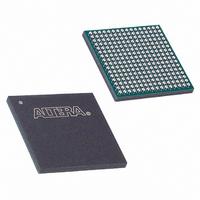EPM570F256I5N Altera, EPM570F256I5N Datasheet - Page 39

EPM570F256I5N
Manufacturer Part Number
EPM570F256I5N
Description
IC MAX II CPLD 570 LE 256-FBGA
Manufacturer
Altera
Series
MAX® IIr
Specifications of EPM570F256I5N
Programmable Type
In System Programmable
Delay Time Tpd(1) Max
5.4ns
Voltage Supply - Internal
2.5V, 3.3V
Number Of Logic Elements/blocks
570
Number Of Macrocells
440
Number Of I /o
160
Operating Temperature
-40°C ~ 100°C
Mounting Type
Surface Mount
Package / Case
256-FBGA
Voltage
2.5V, 3.3V
Memory Type
FLASH
Number Of Logic Elements/cells
570
Family Name
MAX II
# Macrocells
440
Frequency (max)
1.8797GHz
Propagation Delay Time
8.7ns
Number Of Logic Blocks/elements
57
# I/os (max)
160
Operating Supply Voltage (typ)
2.5/3.3V
In System Programmable
Yes
Operating Supply Voltage (min)
2.375V
Operating Supply Voltage (max)
3.6V
Operating Temp Range
-40C to 100C
Operating Temperature Classification
Industrial
Mounting
Surface Mount
Pin Count
256
Package Type
FBGA
No. Of I/o's
160
Propagation Delay
8.7ns
Global Clock Setup Time
1.9ns
Frequency
201.1MHz
Supply Voltage Range
2.375V To 2.625V, 3V To 3.6V
Operating Temperature Range
-40°C To +100°C
Rohs Compliant
Yes
Lead Free Status / RoHS Status
Lead free / RoHS Compliant
Features
-
Lead Free Status / Rohs Status
Compliant
Other names
544-1399
EPM570F256I5N
EPM570F256I5N
Available stocks
Company
Part Number
Manufacturer
Quantity
Price
Company:
Part Number:
EPM570F256I5N
Manufacturer:
ALTERA
Quantity:
26
Part Number:
EPM570F256I5N
Manufacturer:
ALTERA/阿尔特拉
Quantity:
20 000
Chapter 2: MAX II Architecture
I/O Structure
Bus Hold
Programmable Pull-Up Resistor
Programmable Input Delay
MultiVolt I/O Interface
© October 2008 Altera Corporation
1
Each MAX II device I/O pin provides an optional bus-hold feature. The bus-hold
circuitry can hold the signal on an I/O pin at its last-driven state. Since the bus-hold
feature holds the last-driven state of the pin until the next input signal is present, an
external pull-up or pull-down resistor is not necessary to hold a signal level when the
bus is tri-stated.
The bus-hold circuitry also pulls undriven pins away from the input threshold
voltage where noise can cause unintended high-frequency switching. The designer
can select this feature individually for each I/O pin. The bus-hold output will drive
no higher than V
the device cannot use the programmable pull-up option.
The bus-hold circuitry uses a resistor to pull the signal level to the last driven state.
The
specific sustaining current for each V
overdrive current used to identify the next-driven input level.
The bus-hold circuitry is only active after the device has fully initialized. The bus-hold
circuit captures the value on the pin present at the moment user mode is entered.
Each MAX II device I/O pin provides an optional programmable pull-up resistor
during user mode. If the designer enables this feature for an I/O pin, the pull-up
resistor holds the output to the V
The programmable pull-up resistor feature should not be used at the same time as the
bus-hold feature on a given I/O pin.
The MAX II IOE includes a programmable input delay that is activated to ensure zero
hold times. A path where a pin directly drives a register, with minimal routing
between the two, may require the delay to ensure zero hold time. However, a path
where a pin drives a register through long routing or through combinational logic
may not require the delay to achieve a zero hold time. The Quartus II software uses
this delay to ensure zero hold times when needed.
The MAX II architecture supports the MultiVolt I/O interface feature, which allows
MAX II devices in all packages to interface with systems of different supply voltages.
The devices have one set of VCC pins for internal operation (V
sets for input buffers and I/O output driver buffers (V
of I/O banks available in the devices where each set of VCC pins powers one I/O
bank. The EPM240 and EPM570 devices have two I/O banks respectively while the
EPM1270 and EPM2210 devices have four I/O banks respectively.
DC and Switching Characteristics
CCIO
to prevent overdriving signals. If the bus-hold feature is enabled,
CCIO
chapter in the MAX II Device Handbook gives the
CCIO
level of the output pin’s bank.
voltage level driven through this resistor and
CCIO
), depending on the number
CCINT
), and up to four
MAX II Device Handbook
2–31














